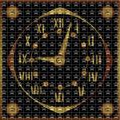Introduction: The Evolution of Tarot in Britain
The journey of tarot within Britain is a fascinating narrative woven through history, culture, and creativity. While tarot cards originated on the European continent in the 15th century as a parlour game, their arrival and subsequent transformation in Britain marked a turning point that would shape the global perception of tarot. British society, with its deep appreciation for mysticism, symbolism, and literary tradition, provided fertile ground for tarot’s evolution from a simple card game into a profound tool for divination and self-reflection. Over the centuries, influential British figures have reimagined tarot’s imagery and meaning, integrating it into broader cultural movements such as spiritualism, the occult revival of the late Victorian era, and the countercultural explorations of the twentieth century. This context set the stage for key contributors—artists, writers, and visionaries—whose work continues to inspire tarot enthusiasts both within the UK and beyond. From Pamela Colman Smith’s iconic illustrations to Rachel Pollack’s insightful interpretations, each has left an indelible mark on the British tarot landscape, ensuring its relevance and resonance in contemporary times.
2. Pamela Colman Smith and the Rider-Waite Legacy
When discussing the evolution of British tarot, it is impossible to overlook the monumental impact of Pamela Colman Smith. Often affectionately known as “Pixie,” Smith was an accomplished illustrator, artist, and storyteller. Her collaboration with Arthur Edward Waite in 1909 resulted in the creation of the Rider-Waite tarot deck—undoubtedly one of the most recognisable and influential decks in both British and global tarot history.
The Artistic Vision Behind the Deck
Smith’s artistic ingenuity brought a new visual language to tarot. Unlike previous decks, which often featured simplistic pip cards for the Minor Arcana, Smith infused each card with rich symbolism and narrative detail. This approach not only made the deck more accessible to novice readers but also introduced a distinctly British flavour through her use of folklore, mediaeval motifs, and subtle references to British culture of the early twentieth century.
Key Innovations Introduced by Pamela Colman Smith
| Innovation | Description | Impact on Tarot Practice |
|---|---|---|
| Illustrated Minor Arcana | Each card in the Minor Arcana depicted a unique scene rather than simple suit symbols. | Enabled story-driven interpretations, increasing accessibility for readers. |
| Symbolic Imagery | Incorporated esoteric symbols blended with British folklore and contemporary themes. | Deepened interpretative layers and cultural resonance within Britain. |
| Cohesive Visual Style | The deck maintained a unified aesthetic across all cards. | Became a blueprint for subsequent British tarot decks. |
Pamela Colman Smiths Enduring Influence
The Rider-Waite deck set new standards for how tarot could be visually represented, influencing countless British artists and deck creators throughout the twentieth century and beyond. Its imagery permeated popular culture—appearing in literature, television, and art exhibitions across the UK. Despite initial anonymity due to publishing conventions of the time (her name was omitted from early editions), Smith’s legacy has been increasingly recognised within British esoteric circles and mainstream culture alike.
A Lasting Cultural Footprint
Pamela Colman Smith’s contributions established not just a visual template but also a uniquely British approach to tarot interpretation—one that blends mystical symbolism with everyday storytelling. Her work remains foundational to understanding how tarot evolved into a vital part of modern British spiritual practice, setting the stage for future innovators such as Rachel Pollack.

3. Arthur Edward Waite: Scholarly Depth and Esoteric Thought
Among the most pivotal figures in British tarot history, Arthur Edward Waite stands out for his rigorous approach to tarot interpretation and his profound influence on the understanding of mysticism within the UK. As a scholar, mystic, and co-creator of the iconic Rider-Waite-Smith deck, Waite’s legacy is woven into the fabric of contemporary tarot practice.
The Intellectual Foundation of Modern Tarot
Waite’s background in scholarly research set him apart from many contemporaries. His involvement with esoteric societies, most notably the Hermetic Order of the Golden Dawn, brought a systematic and analytical lens to the study of tarot. Rather than viewing tarot solely as a tool for fortune-telling, Waite emphasised its symbolic connections to Western mystical traditions such as Kabbalah, alchemy, and Christian mysticism. This approach elevated tarot from superstition to a subject worthy of academic inquiry in Britain.
Redefining Tarot Symbolism
Through his collaboration with Pamela Colman Smith, Waite developed what would become the most influential tarot deck in English-speaking countries. He meticulously revised traditional card meanings and imagery, seeking to clarify their allegorical content. His work “The Pictorial Key to the Tarot” remains an essential reference for both new and experienced practitioners, providing detailed interpretations grounded in historical context rather than mere speculation.
Legacy in British Mystical Culture
Waite’s efforts contributed significantly to shifting British attitudes towards tarot. By embedding esoteric philosophy into the cards’ design and interpretation, he fostered greater public acceptance and intellectual respectability for tarot studies. His influence extends beyond divination, shaping broader discussions around spirituality and personal insight within British culture. Today, Waite’s blend of scholarship and mysticism continues to inspire those who seek depth and meaning through tarot.
4. Aleister Crowley and the Thoth Tarot
Aleister Crowley remains a towering figure in the annals of British tarot history, not only for his notorious reputation within occult circles but also for his transformative influence on tarot philosophy. His collaboration with artist Lady Frieda Harris during the 1930s and 40s resulted in the creation of the Thoth Tarot—a deck that stands as a cornerstone of British occultism and continues to provoke analysis and debate among tarot enthusiasts.
Analysing Crowley’s Impact on Tarot Philosophy
Crowleys approach to tarot was marked by a desire to transcend traditional interpretations, infusing each card with layers of symbolism drawn from Thelema, astrology, Kabbalah, alchemy, and Egyptian mythology. Unlike earlier decks, which often leaned on established Christian iconography or esoteric systems, the Thoth Tarot sought to unify myriad occult traditions into a coherent philosophical framework. This systemic fusion shifted how practitioners approached both tarot readings and magical work, positioning the deck as not just a tool for divination but also a roadmap for spiritual evolution.
Philosophical Innovations Introduced by Crowley
| Element | Description | Impact on British Tarot Tradition |
|---|---|---|
| Thelemic Principles | Incorporation of “Do what thou wilt” as central ethical guidance. | Encouraged individual spiritual sovereignty over dogmatic interpretations. |
| Kabbalistic Structure | Alignment of cards with Tree of Life pathways and Sephiroth. | Deepened connection between tarot and Western esotericism. |
| Astrological Correspondences | Detailed mapping of each card to planetary and zodiacal influences. | Enhanced multidimensional readings and cross-disciplinary study. |
| Alchemical Imagery | Use of transformation symbols throughout the Major Arcana. | Positioned tarot as a tool for personal alchemical change. |
The Thoth Deck: A Cornerstone of British Occultism
The Thoth Tarot has achieved iconic status within the British occult community. Its richly detailed artwork—meticulously executed by Harris under Crowley’s direction—offers interpretive depth unmatched by most contemporary decks. The deck’s publication, delayed until after Crowley’s death due to wartime circumstances, only heightened its mystique. Today, it is revered not only by ceremonial magicians but also by artists and seekers intrigued by its blend of beauty and esoteric complexity.
Cultural Legacy and Continuing Influence
The Thoth Tarot’s legacy endures through its integration in modern British magical societies, academic studies, and popular culture. It has inspired generations of practitioners to view tarot as more than fortune-telling—a dynamic system capable of illuminating the human psyche. Through his radical vision, Aleister Crowley redefined what a tarot deck could be in Britain, ensuring that both his philosophy and his cards remain at the heart of serious tarot study in the UK today.
5. Rachel Pollack: Bridging Transatlantic Perspectives
The Modern Voice in Tarot
Rachel Pollack stands as a pivotal figure in the evolution of tarot, renowned for her profound impact on both British and American tarot communities. Though American by birth, her work is deeply entwined with British tarot traditions, creating a unique bridge between two vibrant cultures. Her groundbreaking book, Seventy-Eight Degrees of Wisdom, is often considered essential reading among British tarot enthusiasts, and has influenced generations of readers and writers across the UK.
Connections to British Traditions
Pollack’s scholarship and intuitive approach revitalised interest in the symbolic depth of tarot, echoing the analytical rigour of British occultists while infusing new perspectives rooted in contemporary spirituality. She engaged extensively with British publishers, participated in UK-based tarot conferences, and maintained close relationships with prominent figures within the British esoteric scene. This cross-pollination helped foster a more inclusive and modern interpretation of tarot within the UK.
Championing Diversity and Inclusivity
One of Pollack’s key contributions was advocating for diversity and inclusivity within tarot practice—a value increasingly embraced by British practitioners. Her writings challenged traditional interpretations, encouraging readers to explore broader social themes such as gender, identity, and transformation. This progressive outlook resonated strongly with the evolving cultural landscape of Britain, shaping discussions around tarot’s role in personal and societal change.
A Lasting Legacy
Rachel Pollack’s ability to bridge transatlantic perspectives not only strengthened connections between British and American tarot communities but also redefined what tarot could represent in a modern context. Her influence endures through her books, teachings, and the countless individuals she inspired on both sides of the Atlantic. As such, she remains an indispensable figure in the ongoing story of British tarot history.
6. Contemporary Influences and the Future of British Tarot
The landscape of British tarot continues to evolve, shaped by both tradition and innovation. In recent years, a new generation of practitioners, artists, and scholars have emerged, each building upon the legacy of figures like Pamela Colman Smith and Rachel Pollack while introducing fresh perspectives. This ongoing evolution can be traced through several key developments.
Emerging Voices and Inclusive Narratives
Modern British tarot is marked by a commitment to inclusivity and diversity. New decks are being created that reflect contemporary British society—embracing a range of identities, cultures, and experiences previously overlooked in traditional decks. These efforts not only broaden tarot’s appeal but also ensure its relevance for younger audiences who seek representation and authenticity.
The Role of Technology in Tarot’s Accessibility
The digital age has transformed how Britons engage with tarot. Online communities, virtual readings, and social media platforms allow for greater access to resources, mentorship, and collaboration. This democratisation means that tarot is no longer confined to esoteric circles; it now plays an active role in the everyday spiritual lives of people across the UK.
Tarot’s Evolving Place in Modern British Society
Today, tarot serves as more than just a tool for divination—it is increasingly recognised as a means of self-reflection, creative inspiration, and community-building. Workshops, public exhibitions, and academic research further legitimise tarot as an area of cultural significance. As attitudes towards spirituality become more open-minded, tarot continues to adapt to the needs of modern Britain.
In summary, the future of British tarot appears bright and dynamic. The enduring impact of key historical figures provides a strong foundation, while contemporary influences promise continued growth and innovation. As new voices contribute to the tradition, tarot’s role within British culture is set to deepen—reflecting the nation’s evolving values and diverse spirit.


